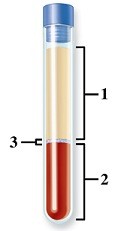Pepsinogen is produced by ________ and is activated by ________, which is secreted by ________
A) parietal cells; carbonic anhydrase (CAH); chief cells
B) chief cells; hydrochloric acid (HCl); parietal cells
C) enteroendocrine cells; carbonic anhydrase (CAH); parietal cells
D) chief cells; carbonic anhydrase (CAH); parietal cells
E) parietal cells; hydrochloric acid (HCl); chief cells
B
You might also like to view...
 In the centrifuged sample of blood illustrated, which number indicates the layer containing water, plasma proteins, nutrients, and waste products?
In the centrifuged sample of blood illustrated, which number indicates the layer containing water, plasma proteins, nutrients, and waste products?
A. 1 B. 2 C. 3 D. None of the answers is correct.
Identify the correct statement regarding the process of denaturation
A) It is affected by low temperatures. B) It is unaffected by changes in pH. C) It is the loss of protein structure. D) It is an increase in enzyme activity. E) It results in decreased substrate availability.
Narrowing of a blood vessel is termed:
A) angioplasty B) venopathy C) arthrosclerosis D) vasodilation E) vasoconstriction
An antagonist is
A. a muscle working in opposition to another muscle. B. the end of the muscle where the action occurs. C. the muscle that does most of the movement. D. the stationary end of the muscle. E. a group of muscles that work together to cause movement.